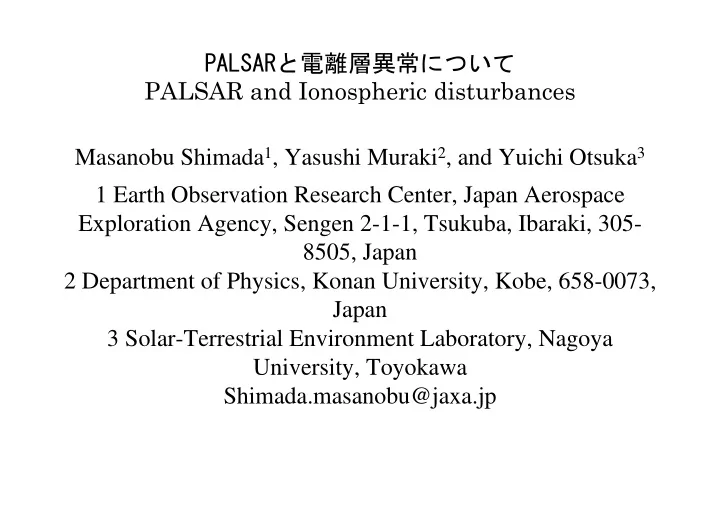

PALSARと電離層異常について PALSAR and Ionospheric disturbances Masanobu Shimada 1 , Yasushi Muraki 2 , and Yuichi Otsuka 3 1 Earth Observation Research Center, Japan Aerospace Exploration Agency, Sengen 2-1-1, Tsukuba, Ibaraki, 305- 8505, Japan 2 Department of Physics, Konan University, Kobe, 658-0073, Japan 3 Solar-Terrestrial Environment Laboratory, Nagoya University, Toyokawa Shimada.masanobu@jaxa.jp
2007夏
2007夏
JERS-1
-16.02 -16.02 -16.02 17.52 14.67 10.16 First PALSAR image detected the scintillat
6 cycles -> 3 TE Coherence drop due to the distance deformation Phase difference Geomagnetic line Coherence
Summary for the streaks Steaks in the amplitude at mainly zero magnetic latitude Range period of shorter cases deviates 1000m~4000m. Steaks deviate the phases as well InSAR Phase in azimuth varies at the mid-latitude regions Questions are Q1: What are the causes for their appearance in range and azimuth? Q2: Are they increased or decreased in time? Q3: The possibility for the correction?
S/C moving direction S/C moving direction
S/C moving direction S/C moving direction
S/C moving direction
ea of PALSAR streaks appearance Jan., 2008-Dec., 2008 Jan., 2009-Macrh, 2009 Jan. 2007-Dec.,2009 March 2006-Dec., 2006 March, 2006-March, 2009 Total number of appearance : 506 : June 2
2 Scenario 1 or 2? B 1 A 171 A+B 55 Under Evaluation
Sun Spot Numbers Sunspot image By “Hinode” satellite March 2009 Decrease
Causes for the stripes Scintillation in range Ion Density variation : Azimuth shift
RSP103_BRS20061126FBD415HH0_W0307149001-03_001
lysis as the scintillation Ne 2 n = 1 − n<1.0 S/C S/C me 0 ω 2 2 λ z / sin θ n 1 Wave length < n 2 θ Z=300km, θ =42deg, λ =23.6 e-5km A little shift Wavelength : Without stripes With stripes 460m
df / dT = df / d ( − 2 R / C ) ⋅ d ( − 2 R / C ) / dT Ne 2 n = 1 − ⎛ ⎞ − 2 R ' C + 2 R dC e 0 ω 2 m = ′ ⎜ ⎟ f ⎝ ⎠ C 2 dT ⎛ ⎞ = j ω f ⋅ − 2 R ' + 2 R dn ⎜ ⎟ ⎝ ⎠ n 2 C nC 0 dT D = 40.3 N ⎛ ⎞ f 2 = j ω f ⋅ − 2 R ' + 2 R dn ⎜ ⎟ ⎝ ⎠ n 2 C nC 0 dT ⎛ ⎞ − e 2 = j ω f ⋅ − 2 R ' + 2 R dN ⎜ ⎟ 2 ε 0 ω 2 m ⎝ ⎠ n 2 C nC 0 dT ⎛ ⎞ − e 2 2 R dN Doppler frequency due to the f de = f 0 ⋅ ⎜ ⎟ ⎝ 2 ε 0 ω 2 m ⎠ n 2 C media variation in azimuth dT
Representative parameters for the ionosphere: Electron mass ( m ): 9.109e-31kg Electric charge ( e ): 1.602e-19 Coulomb Emissivity at space ( e 0 ): 8.854e-12Fm-1 Light speed ( c ):299792458m-1s-1 Angular speed (ω) :2*PAI*1.27e9s-1 If we assume that dN/dT~1.0e9/m^3s-1, f de ~0.2Hz at the positive slope and -0.2Hz at the negative slope. It vibrates in azimuth. Change in Δ y = Δ f D Δ f Δ y : Doppler -> v g − f DD 1Hz : 13m Azimuth shift 0.2Hz : 2.6m mainly very slightly in range. f DD =-500Hz/s V g =6.7km/s
Azimuth and Range shifts S/C Rare -f D Smaller TEC, slower C, Dense projected nearer δ r = k +f D f 2 Δ TEC k=40.28 m3/s2 Rare 10^9*500000*40.28/1.27e9^2 1x 10 ^9/m^3/s =12.4m N
Geometric evaluation using the corner reflector. CRs in Amazon are used for the location shift and the resolution. Geolocation Resolution 2006/w 2007/w 2008/w
Guess for the Ionospheric structure Magnetic line
Coherence
10TEC Unive Bern From rsity U
TEC distribution RSP471
Conclusions Appearance of the streaks, which may be related to the ionospheric disturbance, increases as time goes by while the solar activity decreases. -> needs more evaluation. Streaks appear both in amplitude and phase, and making the image interpretation difficult. Estimated cause of the streaks are that the TEC deviates along the geomagnetic lines and overlaid with the scintillation in range and shift in azimuth (vibration). Comparison with the GCP on the ground, range variation appears in 10m and azimuth variation in 3m (+-). This case shows the electron variation of 1x10^9/m^3/s.
Guess for the structure Geomagnetic line 300?km 700km 200 km
Temperature Electron density distribution
Doppler Frequency : Observation target (ionosphere) changes the Doppler frequency. f ( − 2 R SAR received signal at C ) intermediate frequency : ⎛ ⎞ ⎜ ⎟ ( ) dn / dT df − 2 dR / dT 2 R ⎜ ⎟ dT = j ω f + 2 n 2 Time variation: ⎜ C 0 ⎟ ⎛ ⎞ C 0 ⎜ ⎟ ⎜ ⎟ ⎝ ⎠ ⎝ ⎠ n n Doppler Shift Doppler in by azimuth media n ( T − V p T ) n:electron density fd Shift in Az and r T
Recommend
More recommend